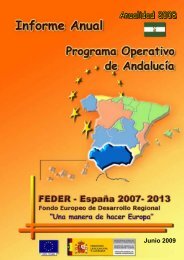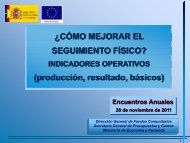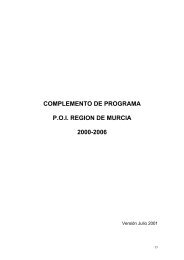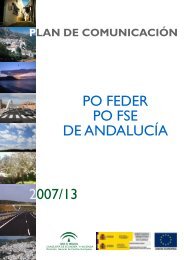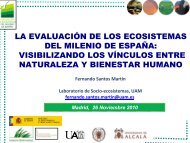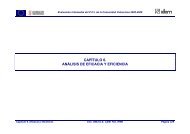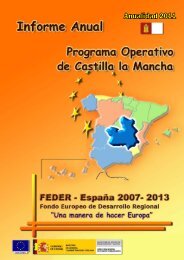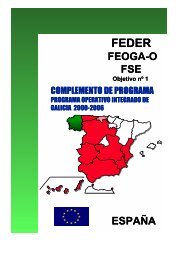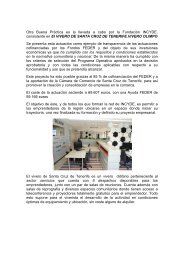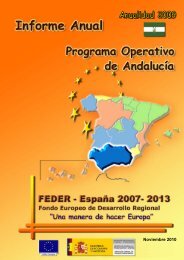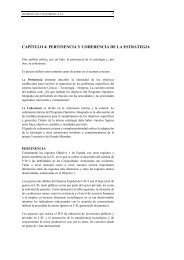- Page 1:
PLAN OBJETIVO Nº 2 2000-2006 TOMO
- Page 5:
INDICE Indice......................
- Page 8 and 9:
- Las indicaciones sobre adicionali
- Page 10 and 11:
la contrapartida es que con el enfo
- Page 13:
CAPITULO PRIMERO Reconversión econ
- Page 16 and 17:
total beneficiable es de 206.916 ha
- Page 18 and 19:
El segundo tipo de zona y en el que
- Page 20 and 21:
menos desarrolladas españolas perd
- Page 22 and 23:
A) Déficits de estructuras y organ
- Page 24 and 25:
d) Desajustes entre oferta y demand
- Page 26 and 27:
del presupuesto comunitario. Como s
- Page 28 and 29:
1.2. Provisión y adecuación de es
- Page 30 and 31:
3.2. Apoyo a proyectos de investiga
- Page 32 and 33:
5.3. Mejora de la infraestructura y
- Page 34 and 35:
4. El desarrollo de las redes de co
- Page 36 and 37:
Ello significa considerar dicha ade
- Page 38 and 39:
COHERENCIA DE LAS ESTRATEGIAS RELAC
- Page 40 and 41:
En cualquier caso, en los apartados
- Page 42 and 43:
3. PARTICIPACION FINANCIERA DE LOS
- Page 44 and 45:
ZONAS OBJETIVO Nº 2: CUADRO FINANC
- Page 46 and 47:
ZONAS OBJETIVO Nº 2 DE ARAGON: CUA
- Page 48 and 49:
ZONAS OBJETIVO Nº 2 DE BALEARES: C
- Page 50 and 51:
ZONAS OBJETIVO Nº 2 DE CATALUÑA:
- Page 52 and 53:
ZONAS OBJETIVO Nº 2 DE MADRID: CUA
- Page 54 and 55:
ZONAS OBJETIVO Nº 2 DE NAVARRA: CU
- Page 56 and 57:
ZONAS OBJETIVO Nº 2 DE PAÍS VASCO
- Page 58 and 59:
ZONAS OBJETIVO Nº 2 DE LA RIOJA: C
- Page 60 and 61:
4. INDICACIONES SOBRE EL CUMPLIMIEN
- Page 62 and 63:
EVALUACIÓN EXANTE DE LA ADICIONALI
- Page 64 and 65:
En el caso de las zonas españolas
- Page 66 and 67:
5.11.Apoyo a las iniciativas locale
- Page 68 and 69:
La autoridad pagadora podrá ser la
- Page 70 and 71:
La arquitectura informática que da
- Page 72 and 73:
La evaluación previa forma parte d
- Page 74 and 75:
- Que las intervenciones se ajusten
- Page 76 and 77:
Los indicadores representativos par
- Page 78 and 79:
Sociedades mercantiles, Empresas, E
- Page 80 and 81:
6.2.2.4. REGLAS Y MÉTODOS DE CONTR
- Page 83:
CAPITULO SEGUNDO Reconversión econ
- Page 87 and 88:
1. - INTRODUCCIÓN El presente docu
- Page 90 and 91:
2. - DESCRIPCIÓN DE LA SITUACIÓN
- Page 92 and 93:
pirenaicos, mucho más caudalosos,
- Page 94 and 95:
CRECIMIENTO (%) DEL PIB EN EL PERIO
- Page 96 and 97:
abordan en definitiva la mejora de
- Page 98 and 99:
• La planificación y la actuaci
- Page 100 and 101:
sólo presentan densidades inferior
- Page 102 and 103:
apartado se citan los aspectos que
- Page 104 and 105:
Concepto 1989 1997 Producción fina
- Page 106 and 107:
escasa dimensión media; casi las t
- Page 108 and 109:
y de la orientación de las activid
- Page 110 and 111:
Otra característica a destacar es
- Page 112 and 113:
dicho cuadro se pone de manifiesto
- Page 114 and 115:
Aunque la balanza comercial es favo
- Page 116 and 117:
• La Administración pública. La
- Page 118 and 119:
2.2.2. - POTENCIALIDADES : FORTALEZ
- Page 120 and 121:
Valorización del territorio a trav
- Page 122 and 123:
• En el ámbito de la innovación
- Page 124 and 125:
NORMATIVA DE LA COMUNIDAD AUTONOMA
- Page 126 and 127:
AMBITO INFRAESTRUCTURAS AMBITO ECON
- Page 128 and 129:
DEBILIDADES AMENAZAS • BAJA TASA
- Page 130 and 131:
2.3.- RESULTADOS DE LA INTERVENCIÓ
- Page 132 and 133:
En el transcurso del periodo anteri
- Page 134 and 135:
• Cofinanciados por el Fondo Euro
- Page 136 and 137:
• Cofinanciados por el FEDER, se
- Page 138 and 139:
mejora del empleo y recursos humano
- Page 140 and 141:
Barcelona determinan un movimiento
- Page 142 and 143:
INFRAESTRUCTURAS PRODUCTIVAS. Indic
- Page 144 and 145:
ealidad ya que, como es sabido, no
- Page 146 and 147:
que el propio colectivo tome concie
- Page 148 and 149:
• Un gasto empresarial en I+D+I (
- Page 150 and 151:
• En 1995 se publicó el Plan Est
- Page 152 and 153:
Principio ambiental de integración
- Page 154 and 155:
INDICADORES BASICOS DE ESTADO AMBIE
- Page 156 and 157:
% de superficie dedicada a zonas re
- Page 158 and 159:
Centros de Interpretación de Arag
- Page 160 and 161:
obtenidos en el campo del medio amb
- Page 162 and 163:
impacto potencial en el ámbito agr
- Page 164 and 165:
SITUACION DE PARTIDA INTERVENCIONES
- Page 166 and 167:
POTENCIAR LA PROMOVER EL GARANTIZAR
- Page 168 and 169:
OBJETIVOS INTERMEDIOS 1.- Impulsar
- Page 170 and 171:
Las acciones en materia de igualdad
- Page 172 and 173:
La dotación de fondos comunitarios
- Page 174 and 175:
sostenible 119 ) y 3 programas hori
- Page 176 and 177:
Eje 1 . Mejora de la competitividad
- Page 178 and 179:
- Cuantificación de objetivos Los
- Page 180 and 181:
- La oferta de servicios empresaria
- Page 182 and 183:
interconexión, se realizan, en est
- Page 184 and 185:
• Eje nº 4: • Eje nº 5: - Con
- Page 186 and 187:
PLAN DE RECONVERSION REGIONAL DE AR
- Page 188 and 189:
PLAN DE RECONVERSION REGIONAL DE AR
- Page 190 and 191:
específicas de las acciones que in
- Page 192 and 193:
VALORACION DE LA SINERGIA DE LAS ME
- Page 194 and 195:
• Medidas que presentan efectos s
- Page 196 and 197:
PLAN DE RECONVERSION REGIONAL DE AR
- Page 198 and 199:
SOSTENIBILIDAD IGUALDAD ENTRE SEXOS
- Page 200 and 201:
2000-2006. En ambos casos, medio am
- Page 202 and 203:
1.1 1.5 1.6 2.1 2.2 2.4 2.6 2.8 3.1
- Page 204 and 205:
ZONAS OBJETIVO Nº 2 DE ARAGON: CUA
- Page 206 and 207:
5. - EVALUACION EX ANTE DEL PLAN. H
- Page 208 and 209:
MATRIZ DE IMPACTOS ESPERADOS EJE 1
- Page 210 and 211:
5.2.2. - IMPACTO SOBRE EL MERCADO D
- Page 212 and 213:
iotecnología, la sociedad de la in
- Page 214 and 215:
IMPACTO SOBRE LA IGUALDAD DE HOMBRE
- Page 216 and 217:
El apartado 2.4.5 de este documento
- Page 218 and 219:
5.3.4. - PRINCIPIOS AMBIENTALES DE
- Page 220 and 221:
6. - ASISTENCIA TECNICA. B B O B B
- Page 222 and 223:
5.3.8. - RECOMENDACIONES Para asegu
- Page 224 and 225:
El mayor nivel de deficiencias en c
- Page 227 and 228:
BALEARES
- Page 229 and 230:
1. INTRODUCCIÓN El presente docume
- Page 231 and 232:
magnitudes físicas, ya que en ning
- Page 233 and 234:
al mantenimiento de extensas áreas
- Page 235 and 236:
Es importante señalar que la depen
- Page 237 and 238:
En cuánto a la distribución intra
- Page 239 and 240:
De esta manera, quedan fuera del Ob
- Page 241 and 242:
• Las Baleares al ser islas tiene
- Page 243 and 244:
Uno de los grandes problemas del me
- Page 245 and 246:
ejemplo el hecho de que las tres cu
- Page 247 and 248:
De todo este estado de cosas se pue
- Page 249 and 250:
La necesidad de alcanzar una mayor
- Page 251 and 252:
empresas destinadas a la fabricaci
- Page 253 and 254:
150% ( gráfico 17) EMPLEO ASALARIA
- Page 255 and 256:
nacionales. Gran parte del turismo
- Page 257 and 258:
La mayor concentración de mayorist
- Page 259 and 260:
obliga, debido a la carencia de Fac
- Page 261 and 262:
2 ya que permitirá potenciar las a
- Page 263 and 264:
presente Programa Operativo con el
- Page 265 and 266:
Islas Baleares para incidir decisiv
- Page 267 and 268:
4.1.4. EJECUCION FINANCIERA En cuan
- Page 269 and 270:
población activa de la comarca, au
- Page 271 and 272:
DESGLOSE DE RESULTADOS POR MUNICIPI
- Page 273 and 274:
Con la medida 1.4 Exraiguer, se han
- Page 275 and 276:
Esta distribución fue modificada p
- Page 277 and 278:
FSE Medida Ayuda FSE PROGRAMAD A Ay
- Page 279 and 280:
5. ESTRUCTURA Y ESTRATEGIA (DESCRIP
- Page 281 and 282:
5.2.1. DESCRIPCION DE LOS EJES PRIO
- Page 283 and 284:
• Eje 2. Medio Ambiente, Entorno
- Page 285 and 286:
de la UIB y es también elegible co
- Page 287 and 288:
Transferencia tecnológica ( creaci
- Page 289 and 290:
La transformación que ha generado
- Page 291 and 292:
- Rehabilitación de barrios degrad
- Page 293 and 294:
Eivissa no estando tan aisladas com
- Page 295 and 296:
) la prestación de todos los servi
- Page 297 and 298:
• Promoción del capital organiza
- Page 299 and 300:
¿Qué procedimiento se ha aplicado
- Page 301 and 302:
Estrategia: Favorecer la generació
- Page 303 and 304:
Apoyar las iniciativas locales que
- Page 305 and 306:
• Para promover el empleo: • Pr
- Page 307 and 308:
• En relación con la aprobación
- Page 309 and 310:
5.6.4. INTERLOCUTORES ECONOMICOS Y
- Page 311 and 312:
ACTUACIÓN DE LOS FONDOS ANTE LOS P
- Page 313 and 314:
ZONAS OBJETIVO Nº 2 DE BALEARES: C
- Page 315 and 316:
7. EVALUACIÓN MEDIOAMBIENTAL 7.1.
- Page 317 and 318:
Es cierto que, a lo largo de los a
- Page 319 and 320:
7.1.2.8. SECTORES PRODUCTIVOS Una l
- Page 321 and 322:
7.1.3.9. RESIDUOS - Ley 11/1997, de
- Page 323 and 324:
Titularidad de las inversiones real
- Page 325 and 326:
• Actuaciones de divulgación y d
- Page 327 and 328:
De cara a modificar la gestión de
- Page 329 and 330:
Además de los problemas descritos,
- Page 331 and 332:
7.3.1.3. SOBRECOSTE INSULAR DEBIDO
- Page 333 and 334:
modificaciones, como consecuencia d
- Page 335 and 336:
Desechos de origen animal y sanitar
- Page 337 and 338:
NUEVAS INFRAESTRUCTURAS (1) Planta
- Page 339 and 340:
‣ Residuos incluidos, a excepció
- Page 341 and 342:
TOTAL FASE II ISLA DE IBIZA 1.414,8
- Page 343 and 344:
‣ Planificación global de las ac
- Page 345 and 346:
sistema han de permitir suministrar
- Page 347 and 348:
2.6 Redes y centros de observación
- Page 349 and 350:
7.5.2.INTEGRACION AMBIENTAL DE LOS
- Page 351 and 352:
7.5.3. EVALUACIÓN AMBIENTAL DE LAS
- Page 353 and 354:
Eje 3: Fomento de la investigación
- Page 355 and 356:
Eje 5: Desarrollo local y urbano Es
- Page 357 and 358:
. Realizar auditorias ambientales d
- Page 359 and 360:
. Incorporación de informes ambien
- Page 361 and 362:
20%. En las actividades industriale
- Page 363 and 364: Mujeres entre 16 y 65 años en rela
- Page 365 and 366: Hombres según el nivel de estudios
- Page 367 and 368: Perfil de las emprendedoras de Bale
- Page 369 and 370: CATALUÑA
- Page 371 and 372: 1. INTRODUCCIÓN: LA ZONA ELEGIBLE
- Page 373 and 374: Mapa 1.1 Zona elegible del objetivo
- Page 375 and 376: La población de Cataluña presenta
- Page 377 and 378: Sin embargo, el periodo comprendido
- Page 379 and 380: Cuadro 2-1. Nivel de empleo por sec
- Page 381 and 382: 1994 (58,5% y 31,4%, respectivament
- Page 383 and 384: itmo de crecimiento de la economía
- Page 385 and 386: Cuadro 2-9. Índice de producción
- Page 387 and 388: Cuadro 2-11. Evolución del número
- Page 389 and 390: Cuadro 2-13. Cuenta de renta de los
- Page 391 and 392: como a la media de países de la OC
- Page 393 and 394: En los últimos años la Generalita
- Page 395 and 396: Infraestructura portuaria En Catalu
- Page 397 and 398: muestran que, tomando como referenc
- Page 399 and 400: Las mujeres y la formación La part
- Page 401 and 402: - Seguir las directrices que se mar
- Page 403 and 404: Talleres de empleo Se han creado en
- Page 405 and 406: Cataluña es una de las zonas de Es
- Page 407 and 408: uso, con la adopción de políticas
- Page 409 and 410: Aguas litorales y playas Desde la J
- Page 411 and 412: subterráneas, minimizando el conta
- Page 413: Cuadro 2-19. Destino final de los r
- Page 417 and 418: - Orientación de las empresas resp
- Page 419 and 420: Contaminantes atmosféricos 1990 19
- Page 421 and 422: El artículo 64 de dicha Ley, recog
- Page 423 and 424: Unión Europea, se reestructura la
- Page 425 and 426: 3. PRINCIPALES RESULTADOS DEL PERÍ
- Page 427 and 428: Cuadro 3-2 Distribución comarcal d
- Page 429 and 430: Las actuaciones realizadas a lo lar
- Page 431 and 432: AMBITO 5. DESARROLLO LOCAL, CALIDAD
- Page 433 and 434: Urbanización y acondicionamiento d
- Page 435 and 436: objetivo 2 (1997-99) destaca la con
- Page 437 and 438: ÁMBITO 5. DESARROLLO LOCAL, CALIDA
- Page 439 and 440: 1999 esta previsto el cumplimiento
- Page 441 and 442: Cuadro 3-8 Distribución de los ben
- Page 443 and 444: Cuadro 3-12 Impacto del gasto elegi
- Page 445 and 446: Respecto a las acciones del FSE, se
- Page 447 and 448: caracterizado además por el increm
- Page 449 and 450: Asimismo, se desarrollarán accione
- Page 451 and 452: Ejes prioritarios y líneas de actu
- Page 453 and 454: Ejes prioritarios y líneas de actu
- Page 455 and 456: ÁMBITOS DE INTERVENCIÓN PRIORITAR
- Page 457 and 458: ÁMBITOS DE INTERVENCIÓN PRIORITAR
- Page 459 and 460: de productos y empresas, y en gener
- Page 461 and 462: distribuidas en todo el mundo, ha t
- Page 463 and 464: establezca una visión global de to
- Page 465 and 466:
segregación vertical y sectorial d
- Page 467 and 468:
4.4.4.2. PROTECCIÓN DE ESPACIOS NA
- Page 469 and 470:
incinerables y el centro para la re
- Page 471 and 472:
íos, no solo en referencia a las a
- Page 473 and 474:
Es importante destacar que este men
- Page 475 and 476:
Se contempla también el empleo de
- Page 477 and 478:
En el próximo periodo puede ser ne
- Page 479 and 480:
que permitan la modernización de C
- Page 481 and 482:
criterios de flexibilidad orientado
- Page 483 and 484:
En el caso de la activi dad náutic
- Page 485 and 486:
mediante la construcción de nuevas
- Page 487 and 488:
Ordenación territorial y urbana En
- Page 489 and 490:
modernismo o la ruta del patrimonio
- Page 491 and 492:
De cara al futuro el gobierno de la
- Page 493 and 494:
La actuación de la Generalitat en
- Page 495 and 496:
Esta estrategia incluye las siguien
- Page 497 and 498:
del trabajo, la obsolescencia de la
- Page 499 and 500:
En la mayoría de los casos, sobre
- Page 501 and 502:
Con el fin de cumplir esta directri
- Page 503 and 504:
- Mejora de la competitividad del e
- Page 505 and 506:
Medida i) Otras medidas forestales
- Page 507 and 508:
2.- Los impactos económicos induci
- Page 509 and 510:
Cuadro 7-4 Distribución de los imp
- Page 511 and 512:
Impacto ⇒ Empleo creado fase de m
- Page 513 and 514:
PRINCIPIO DE SOSTENIBILIDAD 1.Reduc
- Page 515 and 516:
EJE 1. MEJORA DEL ENTORNO PRODUCTIV
- Page 517 and 518:
EJE 1. MEJORA DEL ENTORNO PRODUCTIV
- Page 519 and 520:
EJE 1. MEJORA DEL ENTORNO PRODUCTIV
- Page 521 and 522:
EJE 1. MEJORA DEL ENTORNO PRODUCTIV
- Page 523 and 524:
EJE 2. MEJORA DEL MEDIO AMBIENTE Y
- Page 525 and 526:
EJE 2. MEJORA DEL MEDIO AMBIENTE Y
- Page 527 and 528:
EJE 2. MEJORA DEL MEDIO AMBIENTE Y
- Page 529 and 530:
EJE 3. SOCIEDAD DEL CONOCIMIENTO Y
- Page 531 and 532:
EJE 3. SOCIEDAD DEL CONOCIMIENTO Y
- Page 533 and 534:
EJE 3. SOCIEDAD DEL CONOCIMIENTO Y
- Page 535 and 536:
EJE 5. DESARROLLO LOCAL Y FORMACIÓ
- Page 537 and 538:
EJE 5. DESARROLLO LOCAL Y FORMACIÓ
- Page 539 and 540:
EJE 5. DESARROLLO LOCAL Y FORMACIÓ
- Page 541 and 542:
EJE 5. DESARROLLO LOCAL Y FORMACIÓ
- Page 543 and 544:
EJE 5. DESARROLLO LOCAL Y FORMACIÓ
- Page 545 and 546:
EJE 6. ASISTENCIA TÉCNICA Medida 6
- Page 547 and 548:
Lo expuesto en dicho apartado es un
- Page 549 and 550:
Como se aprecia, para las zonas inc
- Page 551 and 552:
AYUDAS TRANSITORIAS DE CATALUÑA: C
- Page 553 and 554:
Por otra parte, también se pretend
- Page 555 and 556:
Normas de competencia El respeto de
- Page 557 and 558:
Acción: 2.04 Ciclo del agua Fondo:
- Page 559 and 560:
Eje: 5 Desarrollo local, calidad de



